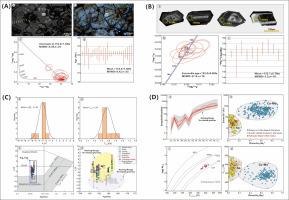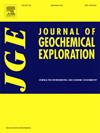Genetic link between concealed granite and tin mineralization in the Yuling tin deposit, Nanling Range, South China: Constraints from zircon and cassiterite U-Pb dating, geochemistry, and Lu-Hf isotopes
IF 3.4
2区 地球科学
Q1 GEOCHEMISTRY & GEOPHYSICS
引用次数: 0
Abstract
The Nanling Range in South China is a world-renowned tin (Sn)-tungsten (W) metallogenic belt. The Yuling deposit is a representative Sn deposit newly discovered in the Nanling Range in recent years. The mineralization of Sn and accompanied Pb-Zn(-Sb) is controlled by faults and hosted in shallow metamorphic sandstone of the Cambrian, with concealed granitic intrusion in the deep. Here, we report for the first time precise in-situ U-Pb dating of zircon and cassiterite, petrogeochemistry, zircon trace element and Hf isotope data from the Yuling Sn deposit to clarify the genetic link between Sn mineralization and the concealed biotite granite. The U-Pb ages of the concealed granite and Sn mineralization are 155.1 ± 0.7 Ma and 154.4 ± 1.4 Ma, respectively, indicating that Sn mineralization occurred simultaneously with Late Jurassic granitic magmatism. Combined with the geological observation that Sn mineralization developed locally near the roof of concealed granite, further attests to the close genetic link between the Yuling Sn deposit and the deep-seated concealed granite. The zircon εHf(t) values range from −5.14 to −1.37 (mean = −2.87), and the two-stage Hf mode ages (TDM2) range from 1.29 to 1.52 Ga (mean = 1.38 Ga), indicating that the source rocks of the Yuling granite primarily originated from the remelting of ancient crustal rocks in the Mesoproterozoic of South China, with the involvement of some juvenile mantle-derived components. The Yuling granite exhibits high content of SiO2, K2O, K2O + Na2O, low content of MgO, CaO, Ba, Sr, Ni, Cr, relatively flat REE patterns and significant negative Eu anomalies. Petrographic and whole-rock geochemical data show that the Yuling granite has an A2-type granite affinity and formed in an intraplate extensional setting of intense crust-mantle interaction similar to that of numerous A2-type granites associated with Sn-W mineralization during the early Yanshanian in the Nanling Range. It may be related to the extension and thinning of the continental lithosphere and asthenosphere upwelling induced by northwestward subduction of the paleo-Pacific plate. Moreover, the factors controlling the Sn mineralization potential of granitic magma were evaluated using zircon trace elements and petrogeochemical data. These findings indicate that the Yuling granite crystallized from higher temperature, lower water content, F-rich, and highly-fractionated reduced granitic magma. Such granitic magma is conducive to generating Sn-rich fluids and has high Sn mineralization potential.

中国南方南岭玉岭锡矿床隐伏花岗岩与锡矿化之间的遗传联系:锆石和锡石 U-Pb 定年、地球化学和 Lu-Hf 同位素的制约因素
中国南方的南岭山脉是世界著名的锡(Sn)-钨(W)成矿带。玉岭矿床是近年来在南岭山脉新发现的具有代表性的锡矿床。锡及伴生铅锌(-Sb)矿化受断层控制,赋存于寒武系浅层变质砂岩中,深部隐伏花岗岩侵入体。在此,我们首次报告了玉岭锑矿床锆石和锡石的原位U-Pb精确定年、岩石地球化学、锆石微量元素和Hf同位素数据,以澄清锑矿化与隐伏花岗岩之间的遗传联系。隐伏花岗岩和锑矿化的 U-Pb 年龄分别为 155.1 ± 0.7 Ma 和 154.4 ± 1.4 Ma,表明锑矿化与晚侏罗世花岗岩岩浆活动同时发生。结合在隐伏花岗岩顶附近局部发育锑矿化的地质观察,进一步证明了豫灵锑矿床与深部隐伏花岗岩之间密切的成因联系。锆石εHf(t)值范围为-5.14~-1.37(平均值=-2.87),两段Hf模式年龄(TDM2)范围为1.29~1.52 Ga(平均值=1.38 Ga),表明玉岭花岗岩的源岩主要来源于华南中新生代古地壳岩的重熔,并有部分幼年地幔衍生成分参与。玉岭花岗岩的SiO2、K2O、K2O + Na2O含量较高,MgO、CaO、Ba、Sr、Ni、Cr含量较低,REE形态相对平缓,Eu负异常显著。岩石学和全岩地球化学数据表明,玉岭花岗岩具有A2型花岗岩的亲缘特征,形成于板块内强烈的壳幔相互作用环境中,与南岭早期燕山期大量与锡-钨矿化有关的A2型花岗岩的形成环境相似。这可能与古太平洋板块向西北俯冲引起的大陆岩石圈的延伸和变薄以及星体上涌有关。此外,利用锆石痕量元素和岩石地球化学数据评估了控制花岗岩岩浆硒成矿潜力的因素。这些研究结果表明,豫灵花岗岩是由温度较高、含水量较低、富含 F 和高度分馏的还原花岗岩岩浆结晶而成。这种花岗岩岩浆有利于产生富含锡的流体,具有很高的锡矿化潜力。
本文章由计算机程序翻译,如有差异,请以英文原文为准。
求助全文
约1分钟内获得全文
求助全文
来源期刊

Journal of Geochemical Exploration
地学-地球化学与地球物理
CiteScore
7.40
自引率
7.70%
发文量
148
审稿时长
8.1 months
期刊介绍:
Journal of Geochemical Exploration is mostly dedicated to publication of original studies in exploration and environmental geochemistry and related topics.
Contributions considered of prevalent interest for the journal include researches based on the application of innovative methods to:
define the genesis and the evolution of mineral deposits including transfer of elements in large-scale mineralized areas.
analyze complex systems at the boundaries between bio-geochemistry, metal transport and mineral accumulation.
evaluate effects of historical mining activities on the surface environment.
trace pollutant sources and define their fate and transport models in the near-surface and surface environments involving solid, fluid and aerial matrices.
assess and quantify natural and technogenic radioactivity in the environment.
determine geochemical anomalies and set baseline reference values using compositional data analysis, multivariate statistics and geo-spatial analysis.
assess the impacts of anthropogenic contamination on ecosystems and human health at local and regional scale to prioritize and classify risks through deterministic and stochastic approaches.
Papers dedicated to the presentation of newly developed methods in analytical geochemistry to be applied in the field or in laboratory are also within the topics of interest for the journal.
 求助内容:
求助内容: 应助结果提醒方式:
应助结果提醒方式:


